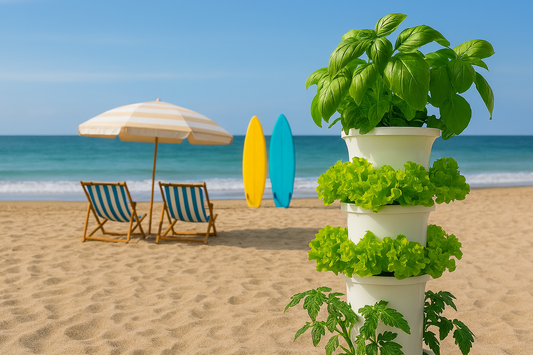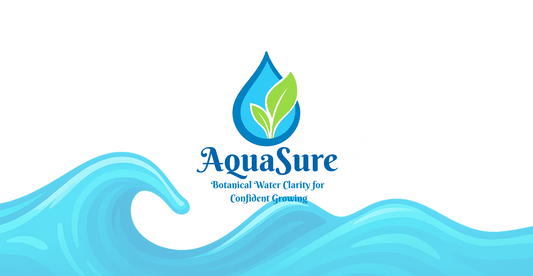
Guide to Growing Peppers in Hydroponic Systems
Introduction
Welcome to our guide on cultivating peppers using hydroponic systems! Whether you’re a seasoned grower or just getting started, this resource will help you optimize plant health, encourage strong fruiting, and maintain a steady harvest. To achieve the best results, growers must carefully manage environmental conditions, nutrient stability, and light intensity—elements that directly impact fruit yield and quality.
Anatomy of a Pepper Plant
Understanding the structure of a pepper plant is crucial for pruning, training, and overall care.

Roots
Roots serve as the "mouth" of the plant, drawing in water and nutrients essential for growth. Hydroponic systems require careful management of water-to-air exchange to keep roots healthy. Using premium nutrients like Veg+Bloom or VBX ensures proper nourishment, while surfactants like PHLO help condition the water and maintain root health.
Node
A node is the point along the stem where leaves, branches, and flowers emerge. Each node is a growth center with the genetic blueprint for future plant development. Strategic pruning at these nodes encourages a bushier, more productive plant.
Internode
The internode is the space between two nodes. The length of the internode determines the plant’s structure—compact internodes result in shorter, bushier plants, while longer internodes produce a more spread-out growth pattern. Depending on the variety, this affects yield, airflow, and accessibility for pruning.
Leaves
As the primary site of photosynthesis, leaves convert light into energy to fuel growth. In peppers, their broad surface efficiently captures light to drive fruit development.

To maximize light absorption, maintaining proper PPFD (Photosynthetic Photon Flux Density) levels is essential:
- Vegetative growth thrives in the 400-600 µmol/m²/s range, encouraging strong leaf development and structural integrity.
- Flowering and fruiting require increased intensity, typically between 600-900 µmol/m²/s, ensuring robust flower set and higher yields.
Consistent light distribution across the canopy prevents uneven growth and stress, reinforcing overall plant health.
Flower
Flowers are the reproductive organs of the pepper plant. They contain male and female structures and, once pollinated, begin forming fruit. Using Shine during the flowering phase provides targeted nutritional support, ensuring stronger flowers, improved pollination, and higher fruit set.

- Gently shaking the plant to encourage natural pollen transfer between flower structures.
- Using a soft brush or cotton swab to collect pollen from the anthers and lightly apply it to the stigma.
- Positioning airflow strategically—a small fan simulating a breeze can help distribute pollen more effectively.
Without manual intervention, flowers may fail to pollinate properly, leading to poor fruit set and inconsistent yield. Integrating these simple pollination techniques ensures maximum fruit production in controlled indoor environments.
Fruit
The fruit—the peppers themselves—develops from fertilized flowers. Peppers vary in size, shape, and spice level, depending on the variety. Shine helps plants transition from flowering to fruit development by supplying key bloom-phase nutrients that increase pepper size and uniformity.
Pruning for Better Production
Hydroponic growers often prune their pepper plants to improve fruit production and plant control. Instead of focusing on height, pruning encourages bushier growth, allowing more lateral branches to develop.
Where to Prune
Prune just above a node(where leaves attach to the stem) . Many growers prune above the 4th node to manage height, but adjusting this based on your system’s constraints can help achieve the desired shape. Pruning at a node prompts the plant to send out two new branches, enhancing bushiness and fruit yield.
Lower Leaves
Removing lower leaves that touch the ground or crowd other foliage improves air circulation and minimizes disease risk
.Suckers—What They Are and How to Handle Them
Pepper plants, like tomatoes and cucumbers, develop suckers—small, fast-growing shoots that emerge in the leaf axils, where leaves meet the main stem. Unlike primary branches, suckers don’t always contribute to fruit production; instead, they can compete for nutrients, diverting energy from flowering and fruiting.

A sucker often appears as a thin, new growth between a node and the main stem, sometimes with a lighter green color and smaller leaves at first. If left unchecked, it will grow into another branch, which may not be as productive as those originating from a main node.
For smaller pepper varieties, keeping suckers can be beneficial, as extra branches may increase overall fruiting sites. However, for larger pepper plants like bell varieties, removing suckers directs more energy into primary fruit-bearing branches, improving yields.
Top Pruning (Topping)
To prevent excessive height, cut the top of the main stem when the plant reaches the desired height. This redirects energy to lateral growth, keeping the plant manageable while maximizing fruiting potential.
How to Prune
Always use clean, sharp scissors or pruning shears to make precise cuts. Sterilizing tools is essential to prevent disease transmission. A hypochlorous acid solution, such as one made using a Force of Nature device, provides effective sanitation. A quick one-minute soak or spray ensures clean cuts without introducing harmful bacteria to your plants.
Continue pruning as the plant matures, focusing on removing non-productive or unhealthy branches to channel energy into fruit development.
Why & When to Prune First Flowers
Many growers are eager to see their plants flower and fruit as soon as possible, but allowing the first flowers to develop too early can limit future productivity. Resist the urge to let these first flowers develop. We know it hurts but what you will get in return will be so worth it.
Why prune the first flowers?
- Encourages stronger vegetative growth – If peppers start forming before the plant has developed sufficient foliage and branching, it can stunt further structural growth.
- Prevents premature energy drain – Early fruiting diverts resources toward producing peppers rather than strengthening the plant’s overall framework, leading to lower yields over time.
- Boosts long-term production – Removing the first few flowers forces the plant to focus on root expansion and lateral branching, resulting in more flowers and fruit later on.
When to prune early flowers?
In most cases, the first flowers should be pruned until the plant is established with sufficient foliage and branching—typically above 6-8 nodes or after the plant has had time to fill out its space within the hydroponic system.
If growing compact varieties, early flowers can be partially pruned rather than removed completely, balancing energy use while still encouraging fruit development.
If plant size looks too small for fruit production, it’s best to prune all early flowers until it reaches the desired structure and vigor.
How to Keep the Plants Producing
A steady pepper supply is every grower’s goal. Unlike some fruiting plants, peppers are continuous producers. Here’s how to maximize their output:
- Harvest Regularly - Picking peppers as soon as they reach the desired size signals the plant to keep producing more fruit.
- Nutrition and EC Stability - Keeping electrical conductivity (EC) levels stable prevents nutrient deficiencies or toxic buildup. Using balanced fertilizers such as Veg+Bloom or VBX ensures consistent nutrition throughout all growth stages.
If looking for maximum flowering and fruit production, adding Shine during bloom enhances bud formation, increases fruit set, and ensures peppers grow larger and more uniform.
Avoiding Unstable Nutrient Blends
Many growers use liquid nutrients or DIY powder mixes, but these methods introduce instability and inconsistency that impact plant health.
Liquid nutrients often settle unevenly, leading to variations in concentration from dose to dose. Over time, some elements precipitate out, reducing effectiveness.
DIY powder formulations like Masterblend require growers to mix separate components manually, increasing the risk of incorrect measurements and imbalanced nutrients. Opting for scientifically calibrated blends like Veg+Bloom or VBX eliminates guesswork, ensuring accurate, stable nutrition for every feeding cycle.
Premium Blend Nutrients & Additives
Take the guesswork out of nutrition. Only use premium, pre-blended formulations that provide consistent balance without the hassle of manual mixing or stage-specific adjustments. Cutting corners with cheap, unstable blends may seem like a cost-saving move, but inconsistent nutrition leads to weak plants, poor yields, and costly corrections down the line.
High-quality, science-backed blends eliminate dosing errors and ensure plants receive exactly what they need at every stage—maximizing health, growth, and fruit production. Invest in stability, not uncertainty.
Watering
Proper watering is critical for hydroponic success. We recommend a 3/15 watering schedule—three minutes on, fifteen minutes off—ensures roots receive adequate moisture while maintaining aeration and preventing waterlogging. Keep in mind, this is for our systems which utilizes a combination of Rockwool and Hydroton pellets. Below are some things to look for when setting your schedule.
Targets for watering
The goal is to maintain optimal root hydration while preventing oversaturation. Ideally, growers should aim for a cycle where:
- Roots remain moist but not soaking wet—enough moisture to sustain the plant without excess water pooling around the base.
- Slight drying occurs between cycles—roots should just begin to dry before the next watering cycle replenishes moisture. This prevents stagnation and promotes oxygen exchange, keeping roots healthy.
- Rockwool retains a steady moisture balance—it shouldn’t feel dry to the touch, but it also shouldn’t be dripping with excess water. Hydroton pellets help regulate this balance by improving drainage.
How to Adjust Based on Your System:
Each grower should monitor:
- Root color and texture – White, firm roots indicate proper hydration, while brown or slimy roots signal excess moisture.
- System drainage efficiency – Ensure Rockwool and Hydroton allow excess water to escape freely, preventing buildup.
- Growth phase adjustments – Younger plants might need shorter intervals (e.g., 2/10 instead of 3/15) to prevent excessive drying, while mature plants can handle more extended dry periods.
Keep in mind, if you are only using Hydroton in your system, they do not retain water which will require even more frequent watering. Our suggestion is to use a combo. Sprout your seeds in Rockwool, place that Rockwool on top of your Hydroton. Even in bucket systems, this will improve the roots aeration and moisture retention.
Environment
Successful pepper cultivation relies on precise environmental control. Unlike traditional soil-based gardening, hydroponics provides an optimized, controlled setting, but maintaining the right balance of humidity, light intensity, and pest prevention is crucial for peak performance. By carefully controlling these variables, growers can ensure consistent production, healthier plants, and more abundant harvests. Lets touch base with these variables.
VPD Management
Maintaining proper Vapor Pressure Deficit (VPD) ensures plants receive the right balance of humidity and temperature for optimal nutrient uptake and transpiration. If you're unfamiliar with how to measure or adjust VPD, refer to our complete VPD guide, which provides detailed explanations on managing airflow, humidity, and temperature for peak growth performance.
PPFD & Light Optimization
Peppers require a specific PPFD (Photosynthetic Photon Flux Density) range for optimal growth. PPFD can be measured easily with a simple meter available here. Too little light can lead to weak, leggy plants, while excessive light can cause stress and bleaching. During vegetative growth, peppers thrive under 400-600 µmol/m²/s, while flowering and fruit production increase with 600-900 µmol/m²/s.
Ensuring even light distribution helps plants develop uniformly while avoiding uneven fruiting patterns. Properly adjusting light height and intensity prevents common grower mistakes that result in poor yields.
Pest and Disease Management
If growing in a tent setup, pest issues are minimal. For other configurations, regularly inspecting plants and using organic controls keeps them healthy and productive.
Conclusion
Growing peppers hydroponically is a rewarding and highly productive venture. By following these best practices—optimizing nutrient stability, VPD, and PPFD levels—you’ll ensure consistent yields and vibrant fruiting throughout the growing cycle.
Think critically about your current setup: Are your nutrient levels stable? Are you managing VPD effectively? Is your lighting intensity optimized for the best results?
For growers who want the most efficient system possible, incorporating these techniques will maximize fruit production while reducing plant stress. If you have any questions, Join the Discussion—our community is here to help!





